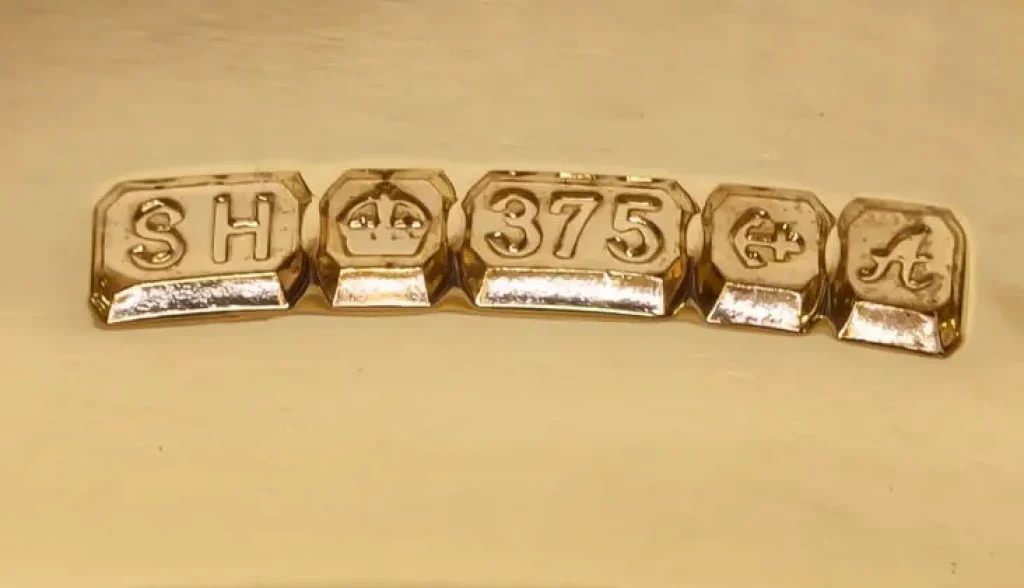375 gold is just one of many different types of hallmarks. A gold content of 375 signifies that the purity of gold is 37.5%, often expressed as 9k gold in carats. This indicates that the remaining 62.5% is composed of other metals such as copper, nickel, or occasionally silver. Fineness, on the other hand, denotes the measurement of gold content, with pure gold having a fineness of 999.9% or 24 carats.

375 Gold Composition
375 Gold consists of 37.5% pure gold, 42.5% silver, and 20% copper. This composition results in a gold alloy that is more durable and less expensive than higher-carat gold. The addition of silver and copper contributes to its distinct color and hardness, making it suitable for a variety of jewelry and decorative applications.
375 Gold Hallmark
The 375 hallmark indicates that an item is made of 9-carat gold, with 37.5% of its weight being pure gold. It is a common fineness mark used to indicate the proportion of precious metal in an alloy. Additionally, metals such as copper, silver, nickel, or zinc are mixed with the gold, composing the remaining 62.5%.
Hallmarking enables accurate valuation of gold items based on weight and prevailing gold prices, providing transparency and confidence for buyers and sellers in determining the item’s value and authenticity. The 375 hallmark is popular in jewelry due to its affordability and durability, making it suitable for everyday wear.
History of Gold Hallmarks
In 1972, the UK joined the International Convention of Hallmarks, establishing mutual recognition of hallmarks among member countries. The convention introduced the Common Control Mark (CCM), represented by balance scales with the fineness indicated by parts per thousand on intersecting circles. This standardized symbol enables easy identification of 375 gold, regardless of its country of origin.
Foreign Gold Hallmarks
European countries, including Austria, Croatia, Denmark, and Switzerland, follow the International Convention on Hallmarking, which introduced the Common Control Mark (CCM) for gold. Russian gold has its own Kokoshnik mark, while Italian gold doesn’t legally require hallmarking. Additionally, Selling gold items from non-EU or convention countries requires assaying and hallmarking in a signatory nation like the UK.
Hallmarking Standards and Regulations
Hallmarking standards and regulations ensure the quality, authenticity, and integrity of precious metal items like gold, silver, and platinum. Therefore, Authorized assay offices or regulatory bodies enforce these standards, which vary across countries.
Significantly, manufacturers stamp official marks, known as hallmarks, on items to provide information about the metal’s purity, origin, and the manufacturer’s identity. Moreover, they serve as a guarantee of quality and assist consumers in making informed purchasing decisions.
Shades
There are different shades of Gold and it depends on which metals are making alloys with gold. White Gold, Yellow Gold, and other Colored golds are the shades of 375 or 9-carat Gold.

Yellow Gold
It is the timeless and widely favored shade of 375 gold. Achieving it involves combining pure gold with metals like copper, silver, and zinc. As a result, this alloying process gives yellow gold its distinctly warm and rich yellow hue, reminiscent of pure 24k gold but slightly lighter in color.
White Gold
White gold is a popular shade of 375 gold jewelry.
Creating it involves mixing gold with white metals like palladium, nickel, and silver. Additionally, to enhance its appearance, manufacturers often use rhodium plate white gold, giving it a bright and silvery-white look.
Other Colored Gold
By alloying it, a diverse range of colored gold shades can be created. Furthermore, these shades include green gold, blue gold, and purple gold. In short, these unique alloys offer a captivating and distinct appearance, adding a touch of individuality and creativity to gold jewelry designs.
- Green gold: Alloyed with silver and copper to achieve a greenish hue.
- Gray/Black gold: Alloyed with cobalt or ruthenium for a gray or black color.
- Blue gold: Alloyed with iron or indium to create a blue-toned gold.
- Purple gold: Alloyed with aluminum, resulting in gold with violet tones.





